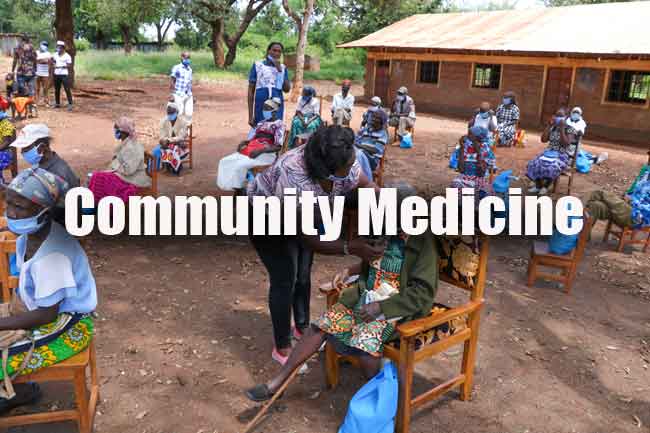Community Medicine Quiz
Are you searching for Community Medicine Quiz Papers? Here we provided last five years Community Medicine Quiz Papers with solutions. Hence applicants can practice these Community Medicine Quiz Papers to get experience. We have given Community Medicine Quiz Papers.

People can check Community Medicine Quiz Papers by visiting the below links. Looking for the direct links for downloading Community Medicine Quiz Papers? Hence, the interested candidates can get the respective Community Medicine Quiz Papers without being paid. Download the Community Medicine Quiz Papers here and prepare well for the exam.
Quiz Papers on Community Medicine
1. What is the cut-off point of Haemoglobin (in gm/dl) to diagnose anaemia during pregnancy ?
(1) 12
(2) 11
(3) 10
(4) 09
2. Which year, from 1 — 4 years of age of a child is having the highest risk of mortality ?
(1) 0-1 year
(2) Second year
(3) Third year
(4) Fourth year
3. “UJJAWALA” scheme is launched for one of the following service :
(1) Prevention of respiratory illnesses by “YOGA”.
(2) Comprehensive services to victims of trafficked commercial sexual exploitation.
(3) Affordable light to all urban & rural area by supply of LEDs.
(4) LPG connection to all below poverty line families for smokeless kitchen to prevent respiratory and eye problems.
4. Gold standard to assess gestational age in the first trimester of pregnancy is
(1) Foetal Heart Sound
(2) Ultra Sonography
(3) Height of uterus
(4) 9 calendar months and seven days after first day of last period of menstruation
5. Correct recommendation for breast feeding is
(1) Exclusive breast feeding for four months followed by weaning
(2) Exclusive breast feeding for six months followed by weaning
(3) Colostrum should be avoided for initial 6 hours of child birth
(4) Baby should allowed breast feeding till age one
6. Average birth weight of Indian babies is
(1) 2.8 kgs
(2) 2.5 kgs
(3) 3.1 kgs
(4) 3.5 kgs
7. Maternal mortality ratio is
(1) Maternal deaths to live births and still births
(2) Maternal deaths per 1000 live births
(3) Maternal deaths per one lakh live births
(4) Maternal deaths per one lakh population
8. Discussion on importance and management of breast feeding practices with pregnant female is a step in
(1) Reproductive & child health program
(2) Malnutrition prevention policy
(3) Baby friendly hospital initiative
(4) Prenatal counselling at home initiative
9. Most accepted and sensitive indicator of health status and health care of community.
(1) Maternal mortality rate
(2) Infant mortality rate
(3) Child mortality rate
(4) Age specific fertility rate
10. Early diagnosis of protein energy malnutrition can be done by one of the following charts :
(1) Growth chart
(2) Snellel chart
(3) Gnatt chart
(4) R.O.C. (Receiver Operating Characteristics) chart
11. Perinatal period includes
(1) Period from 28 weeks of gestation to one week of life
(2) Period from conception to one week of life
(3) Period from 28 weeks of gestation to child birth
(4) Period one week before and one week after child birth
12. Recommended dose of Folic acid during pregnancy is
(1) 200 micrograms / day
(2) 300 micrograms / day
(3) 400 micrograms / day
(4) 500 micrograms / day
13. Following one is the child survival rate
(1) 1000 minus under five mortality rate / 2
(2) 1000 — (minus) under five mortality rate / 10
(3) Under five mortality / 1000
(4) Under five mortality rate / 100
14. A boy involve in antisocial activities. What should be the age of boy to consider as Juvenile crime ?
(1) Less than 16 years of age
(2) Less than 17 years of age
(3) Less than 18 years of age
(4) Less than 21 years of age
15. Adolescent age is
(1) 14-19 years
(2) 10-19 years
(3) 14-16 years
(4) 13-18 years
16. Disability occurs due to ageing process
(1) Lymphadenopathy
(2) Loss of appetite
(3) Cataract
(4) Difficulty in swallowing
17. In India largest voluntary organization for geriatric population is
(1) Old age organization
(2) Project for disabled
(3) Helpage India
(4) Old age project to make self help group
18. Contribution of Geriatric population in total population of country
(1) 12%
(2) 16%
(3) 6%
(4) 8%
19. Life style modifications for prevention of risk factors of non-communicable diseases in Geriatric population is which level of prevention ?
(1) Primary level
(2) Secondary level
(3) Tertiary level
(4) Primordial prevention
20. Cultural diffusion between people of two different cultures is known as
(1) Socialization
(2) Civilization
(3) Acculturation
(4) Community Participation
| MCQs | Old Papers |
| Quiz | Sample Papers |
| Mock Test | Model Question |
| Practice Papers | Previous Question |
| Important Question |
21. Alcoholism is a
(1) Social pathology
(2) Social reputation
(3) Social stigma
(4) Socio-economic status
22. Normal intelligence quotient of a boy is
(1) 50-69
(2) 70-79
(3) 80-89
(4) 90-109
23. Kuppuswami socio-economic status scale is based on
(1) Rural, Urban residential area and Occupation.
(2) Education, Occupation and Income.
(3) Wealth Index and Health Index.
(4) Education, Purchasing Power and Amenities Available.
24. Cortelation between two variables is presented in which of the following :
(1) Pictogram
(2) Simple bar diagram
(3) Scatter diagram
(4) Pie diagram
25. “Root mean square deviation” Is
(1) Mean deviation
(2) Standard deviation
(3) Average deviation
(4) Sample deviation
26. Dual record system as a source of health information is
(1) Sample registration system
(2) Record linkage
(3) Hospital record system
(4) System of disease notification
27. Values covered between two standard deviation on either side of mean in a normal distribution curve is
(1) 95%
(2) 99%
(3) 68%
(4) Equal to one
28. Sampling error can be reduced by
(1) Increase in sample size
(2) Decrease in sample size
(3) Change in exclusion criteria
(4) Taking consent from study subject
29. “Confidence Limit” is calculated by
(1) Standard error of mean
(2) Median and standard deviation
(3) Mean deviation & median
(4) Median and percentile
30. In Immunization coverage survey under national immunization program, the sample of children includes
(1) 20 cluster 5 children
(2) 30 cluster 5 children
(3) 20 cluster 7 children
(4) 30 cluster 7 children
31. CHI-SQUARE TEST can be used on more than two groups, where we require test of significance of difference between one of the following :
(1) Two proportions
(2) Two means
(3) Two p-value
(4) Two degree of freedom
32. Births and deaths in a community should be registered with in — (days)
(1) 7 days
(2) 14 days
(3) 21 days
(4) Birth 7 days and death 14 days
33. To study the role of a factor when the observations are made before and after the factor to play role on one sample of individuals, the test applied to assess difference between observed values is
(1) Unpaired t — test
(2) Paired t — test
(3) Fischer test
(4) Chi — square test
34. Cultural barrier of communication includes
(1) Hearing defects
(2) Neurosis
(3) Language variation
(4) Poor attention span
35. Example of one-way-communication is
(1) Lecture
(2) Symposium
(3) Seminar
(4) Demonstration
36. In health communication, exhibitions and health museum are which type of approach to communicate
(1) Interpersonal approach
(2) Individual to Group approach
(3) Mass approach
(4) Behaviour change approach
37. “A series of speeches on a selected subject by expert persons and at the end audience may raise questions” this method is known as
(1) Workshop
(2) Symposium
(3) Panel discussion
(4) Group discussion
38. Delphi technique includes all of the followings except :
(1) Forecasting method using set of questionaries to solve the problem.
(2) It requires adequate time, skill and commitment of participants.
(3) Face to face meeting of expert to make forecast.
(4) Building consensus on the basis of feedback from questionaries to solve the problem.
39. In Health education, people are expected to
(1) Learn to behave healthy
(2) Learn to earn behaviour
(3) Teaching and training
(4) Voluntary adoption of healthy living
40. One Anganwadi centre in difficult area serve population of following numbers :
(1) 1000-2000
(2) 100-300
(3) 300-800
(4) 900-1000
41. In plain area one sub-centre serve population of following numbers :
(1) 3000
(2) 5000
(3) 2000
(4) 1000
42. Indian council for child welfare is a
(1) Part of family welfare
(2) GOVT. Agency
(3) Non-Government agency
(4) International network in India regarding child welfare
43. Which of the following is not true for community health centre ?
(1) Serving 40,000 population
(2) 30 beds and specialists care is available
(3) One community health officer is posted there
(4) Implement all the activities of national health programs
44. For Central Government health scheme all followings are true except
(1) Deals with central government employee of Delhi.
(2) It is a contributory scheme.
(3) It is for central government employee.
(4) Provide outpatient and indoor services of employees.
45. Village health and Nutrition day should be organised
(1) Twice in a month
(2) On a fixed day per week
(3) After every tenth day
(4) Once in a month
46. Which of the following statement is false pertaining to principles of primary health care ?
(1) All people should share health services equally.
(2) Village health guide and trained dais are example of community participation.
(3) Establishment of Luxurious hospitals in out reach area to provide appropriate technologies.
(4) Inter sectorial coordination can avoid duplication of health activities.
47. Following is indigenous system of medicine :
(1) Allopathy
(2) Ayurveda
(3) Anganwadi
(4) Village health worker
48. Which of the following health worker maintain eligible couple register ?
(1) Accredited social health activist
(2) Dais
(3) Auxilliary Nurse Midwife
(4) Lady Health Visitor
49. International Conference (1978) at USSR gave a new approach for health care which is
(1) Multipurpose health worker as a health care provider
(2) Essential health care
(3) Basic health care
(4) Primary health care
50. Analysis of cost on health care and profits in terms of results achieved is known as
(1) Cost effective analysis
(2) Cost benefit analysis
(3) Cost — Health and system analysis
(4) Cost — input analysis



